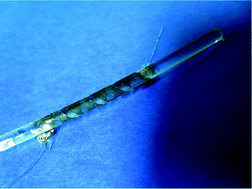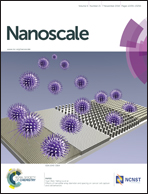Torsion sensors of high sensitivity and wide dynamic range based on a graphene woven structure†
Abstract
Due to its unique electromechanical properties, nanomaterial has become a promising material for use in the sensing elements of strain sensors. Tensile strain is the type of deformation most intensively studied. Torsion is another deformation occurring in everyday life, but is less well understood. In the present study a torsion sensor was prepared by wrapping woven graphene fabrics (GWFs) around a polymer rod at a specific winding angle. The GWF sensor showed an ultra-high sensitivity with a detection limit as low as 0.3 rad m−1, indicating its potential application in the precise measurement of low torsions. The GWFs were pre-strained before wrapping on polydimethylsiloxane (PDMS) to improve the tolerance of the sensor to high torsion. The microstructure of the GWFs at different torsion levels was monitored using an optical microscope. The results demonstrated the formation of GWF waves and cracks under high torsion, a critical factor in determining the electromechanical properties of a GWF sensor.


 Please wait while we load your content...
Please wait while we load your content...